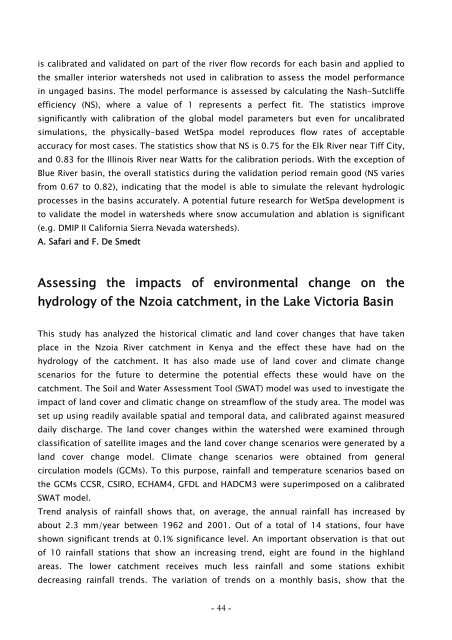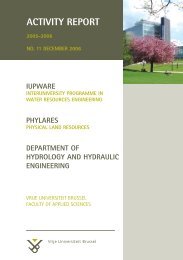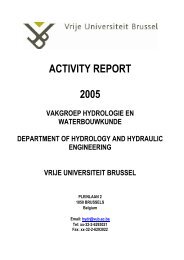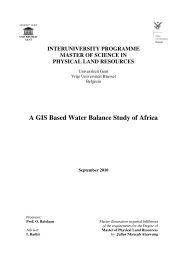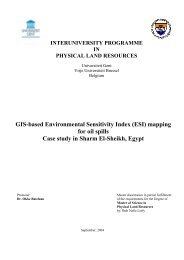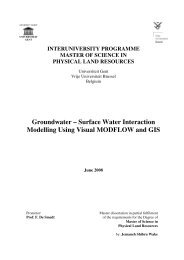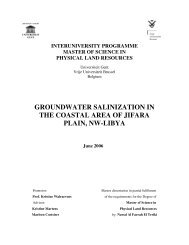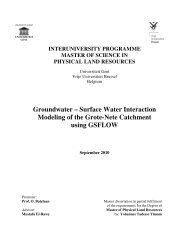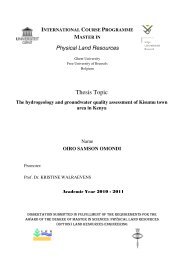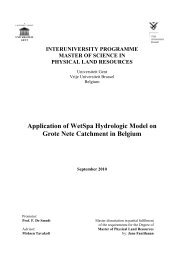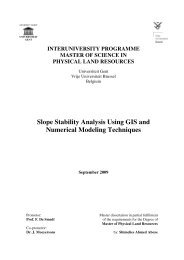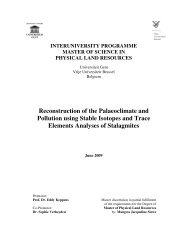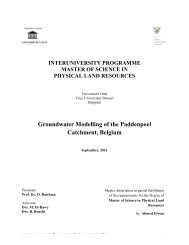C O N T E N T S - Physical Land Resources - Vrije Universiteit Brussel
C O N T E N T S - Physical Land Resources - Vrije Universiteit Brussel
C O N T E N T S - Physical Land Resources - Vrije Universiteit Brussel
You also want an ePaper? Increase the reach of your titles
YUMPU automatically turns print PDFs into web optimized ePapers that Google loves.
is calibrated and validated on part of the river flow records for each basin and applied tothe smaller interior watersheds not used in calibration to assess the model performancein ungaged basins. The model performance is assessed by calculating the Nash-Sutcliffeefficiency (NS), where a value of 1 represents a perfect fit. The statistics improvesignificantly with calibration of the global model parameters but even for uncalibratedsimulations, the physically-based WetSpa model reproduces flow rates of acceptableaccuracy for most cases. The statistics show that NS is 0.75 for the Elk River near Tiff City,and 0.83 for the Illinois River near Watts for the calibration periods. With the exception ofBlue River basin, the overall statistics during the validation period remain good (NS variesfrom 0.67 to 0.82), indicating that the model is able to simulate the relevant hydrologicprocesses in the basins accurately. A potential future research for WetSpa development isto validate the model in watersheds where snow accumulation and ablation is significant(e.g. DMIP II California Sierra Nevada watersheds).A. Safari and F. De SmedtAssessing the impacts of environmental change on thehydrology of the Nzoia catchment, in the Lake Victoria BasinThis study has analyzed the historical climatic and land cover changes that have takenplace in the Nzoia River catchment in Kenya and the effect these have had on thehydrology of the catchment. It has also made use of land cover and climate changescenarios for the future to determine the potential effects these would have on thecatchment. The Soil and Water Assessment Tool (SWAT) model was used to investigate theimpact of land cover and climatic change on streamflow of the study area. The model wasset up using readily available spatial and temporal data, and calibrated against measureddaily discharge. The land cover changes within the watershed were examined throughclassification of satellite images and the land cover change scenarios were generated by aland cover change model. Climate change scenarios were obtained from generalcirculation models (GCMs). To this purpose, rainfall and temperature scenarios based onthe GCMs CCSR, CSIRO, ECHAM4, GFDL and HADCM3 were superimposed on a calibratedSWAT model.Trend analysis of rainfall shows that, on average, the annual rainfall has increased byabout 2.3 mm/year between 1962 and 2001. Out of a total of 14 stations, four haveshown significant trends at 0.1% significance level. An important observation is that outof 10 rainfall stations that show an increasing trend, eight are found in the highlandareas. The lower catchment receives much less rainfall and some stations exhibitdecreasing rainfall trends. The variation of trends on a monthly basis, show that the- 44 -


